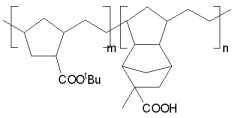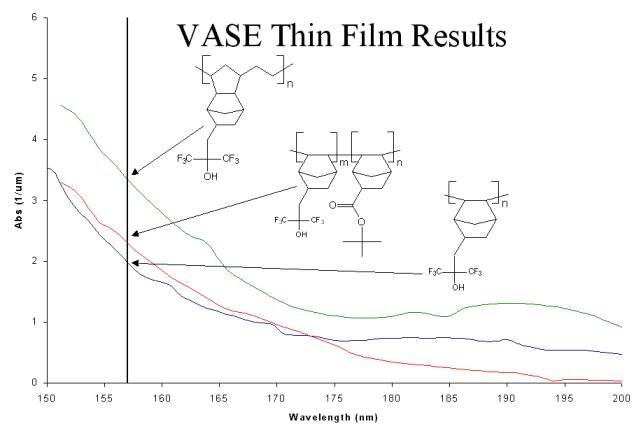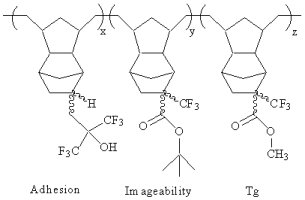|
|
||
|
Ring-Opening Metathesis Polymerization (ROMP) of Functionalized Dinorbornene Monomers for 157 nm Lithography Applications The purpose of this document is to provide timely public access to the 157 nm resist development work being done in our laboratories under contract from International SEMATECH. It is our goal and SEMATECH's goal to disseminate this information as rapidly and widely as possible in hope that doing so will accelerate the availability of 157 nm resist materials to the members of International SEMATECH. Ring-Opening Metathesis PolymerizationROMP is once again being investigated as a viable polymerization pathway for 157 nm lithography. In conjunction with Daniel Sanders of CalTech, ROMP using the Grubbs catalyst and optimal chain transfer agents (CTA) to control polymer molecular weight. Monomers to be used will be functionalized dinorbornenes in order to increase the glass transition temperature of the resultant polymers. Primary concern centers on what trade-off will be paid in optical density with the addition of another norbornene ring. ROMP and 193 nm Lithography 
ROMP was previously explored in the Willson group for use in 193 nm lithography, using an iridium-based catalyst (K2IrCl6). Monomers used were based on norbornenes, with dinorbornenes used at times as well. During the project, glass transition temperatures were able to be increased above 130 'C. However, problems where encountered when trying to image the ROMP polymers, such as swelling and incompatabilities with some PAGs. ROMP and 157 nm Lithography Now ROMP is being investigated yet again for use at 157 nm, this time using functionalized dinorbornene monomers to for the first set of polymers. The Grubbs catalyst, a ruthenium-based catalyst, is being used in lieu of the iridium catalysts. The homopolymer of the dinorbornene hexafluorocarbinol monomer, which shows that the Grubbs catalyst is tolerant of the highly polar and acidic hexafluorocarbinol group. 
Preliminary data shows that the consequence of incorporating a second ring into the monomer unit is not as high as intuition might suggest. Using Variable Angle Scattering Ellipsometry (VASE), the homopolymer of the dinorbornene hexafluorocarbinol, cast from cyclohexanone, shows a thin film absorbance of approximately 3.2/um. These results give reason to further pursue the ROMP polymers and see if different substituents can yield all the functional modules required for a polymeric resist material. 
Future Work

References
Version History Original page created 05/21/01 Return to main 157 nm page
| |
|
|
||

